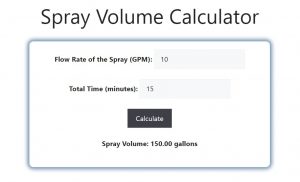About Spray Volume Calculator (Formula)
The Spray Volume Calculator is an essential tool for farmers, gardeners, and professionals in the agricultural sector who need to determine the amount of liquid to be sprayed over a specific area. Understanding the required spray volume is crucial for effective pest control, fertilization, and irrigation. By using this calculator, you can optimize your spraying process, reduce waste, and ensure that your plants receive the right amount of treatment. In this article, we will outline the formula, provide a step-by-step guide on how to use the calculator, offer a practical example, and answer frequently asked questions.
Formula
The formula for calculating the spray volume is:
Spray Volume = Flow Rate * Total Time
Where:
- Flow Rate is the rate at which the spray liquid is dispensed, typically measured in liters per minute or gallons per minute.
- Total Time is the duration of spraying, measured in minutes.
How to Use
- Determine Flow Rate: Identify the flow rate of your sprayer. This information is usually provided by the manufacturer and can be measured in liters per minute or gallons per minute.
- Measure Total Time: Decide how long you plan to spray in minutes.
- Apply the Formula: Use the formula to calculate the total spray volume by multiplying the flow rate by the total time.
- Adjust if Necessary: Based on the calculated spray volume, adjust your spraying strategy, including the dilution of products or the area to be covered.
Example
Let’s say you have a sprayer with a flow rate of 10 liters per minute, and you plan to spray for a total time of 15 minutes.
Step 1: Identify Flow Rate
Flow Rate = 10 liters/minute
Step 2: Measure Total Time
Total Time = 15 minutes
Step 3: Apply the Formula
Spray Volume = Flow Rate * Total Time
Spray Volume = 10 liters/minute * 15 minutes
Step 4: Calculate
Spray Volume = 150 liters
In this example, you would need a total spray volume of 150 liters for the specified duration.

FAQs
- What is spray volume?
Spray volume refers to the total amount of liquid applied to a specific area during a spraying operation. - Why is calculating spray volume important?
Calculating spray volume helps ensure effective treatment and minimizes waste, leading to cost savings and better crop health. - What units can flow rate be measured in?
Flow rate can be measured in liters per minute (L/min), gallons per minute (GPM), or other volume units depending on the region. - How can I measure my sprayer’s flow rate?
You can measure the flow rate by collecting the liquid dispensed over a specific time period and calculating the volume per minute. - Can I adjust the flow rate on my sprayer?
Many sprayers allow you to adjust the flow rate through nozzle selection or pressure adjustments. - What factors affect the flow rate?
Factors include nozzle size, pressure, viscosity of the liquid, and the type of sprayer used. - How can I ensure uniform coverage when spraying?
Maintain a consistent speed while spraying and ensure the sprayer is calibrated properly for even distribution. - What should I do if I over-apply spray volume?
If you over-apply, consider re-evaluating your application method and the necessary flow rate to avoid future excess. - Is it necessary to calibrate my sprayer?
Yes, regular calibration ensures accurate flow rates and effective treatment application. - How do environmental conditions affect spray application?
Wind, temperature, and humidity can affect the dispersion and effectiveness of sprayed solutions. - Can I use this calculator for different types of sprayers?
Yes, the spray volume calculation can be applied to any type of sprayer, provided you know the flow rate and total spraying time. - What is the best practice for mixing spray solutions?
Always follow the manufacturer’s instructions for mixing ratios to ensure effectiveness and safety. - How often should I check my sprayer’s flow rate?
It’s a good practice to check your sprayer’s flow rate before each use, especially if you are using it for different applications. - What should I do if my sprayer is not delivering the expected flow rate?
Inspect the sprayer for clogs, leaks, or damaged parts that could affect its performance. - Can I use the calculator for irrigation purposes?
Yes, the spray volume calculator can be used for both spraying and irrigation applications. - How do I ensure the safety of myself and the environment while spraying?
Always wear appropriate protective gear and follow safety guidelines, and avoid spraying during windy conditions to minimize drift. - Is there a recommended height for spraying?
Yes, maintaining the correct height ensures better coverage and minimizes the risk of overspray. - Can I store unused spray solution?
Only store unused spray solution if the manufacturer’s instructions permit it, and always keep it in a safe, labeled container. - What types of products can be sprayed?
Many products, including pesticides, herbicides, and fertilizers, can be applied using spray volume calculations. - How can I improve the efficiency of my spraying operations?
Regular maintenance of equipment, proper calibration, and understanding of product requirements can all enhance efficiency.
Conclusion
The Spray Volume Calculator is a valuable tool that helps you determine the right amount of liquid needed for effective application in agricultural and gardening tasks. By using the formula and steps outlined in this article, you can optimize your spraying process, ensuring that your plants receive the appropriate treatment while minimizing waste. Regularly monitoring your flow rate and total spraying time will lead to better results and a healthier environment for your crops.
